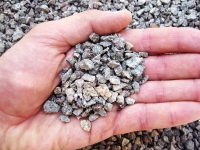4/8 mm porphyry grit (25 kg)
PORPHYRY GRAIN 4/8 mm (25 Kg).
Porphyry (rhyolithic ignimbrite) is a magmatic rock which constitutes one of the last effusive units of the Permian volcanic complex (270 Ma) of the Atesina region.
The rock structure is porphyritic with 35-40% (by volume) of well crystallized minerals in a microcrystalline or glassy groundmass.
Minerals are, in volume and in decreasing order of abundance: quartz, sanidine, plagioclase, rare biotite.
MEDIUM CHEMICAL ANALYSIS
SiO2: 74.14%
P2O2: 0.08%
Al2O3: 13.01%
K2O: 4.69%
Fe2O3: 1.34%
FeO: 0.42%
MnO: 0.05%
CaO: 0.78%
Na2O: 2.70%
TiO2: 0.16%
MgO: 0.36%
H2O: 0.62%
CP: 1.93%
TECHNICAL FEATURES
Release of dangerous substances : NDP;
Flexural strength : 25.2 MPa;
Durability of flexural strength before frost : 23.4 MPa;
Durability of flexural strength after 56 frost cycles : 25.2 MPa;
Apparent density : 2574 Kg / mc;
Wear by abrasion : 14.8mm;
Water absorption at atmospheric pressure : 0.6%;
Compressive strength: 122 MPa;
Durability of compressive strength before freezing : 167 MPa;
Durability of compressive strength after 56 frost cycles : 165 MPa.
FUNCTIONAL CHARACTERISTICS AND FIELDS OF USE
Natural inert, ideal for:
? build substrates for plants that require the presence of silica;
? decorative if placed above the root system of potted plants or on the ground;
? as a background for aquariums where you want to reconstruct a backdrop made up of real aquatic plants;
? mulch flower beds or areas of the garden where you want to avoid the growth of grasses or weeds.
NB: PACKAGING NEWS
It should be noted that the product will arrive in a bag (with a total weight of 25 kg, as specified in the title of the advertisement) labeled and packaged, according to the terms of the law, by the employees of Geosism & Nature sas
NB: GUARANTEES
Geosism & Nature sas certifies that the rock sold in this listing is totally natural and has not undergone any type of chemical treatment that could in any way pollute the soil or the crops with which it comes into contact. For the same reasons, Geosism & Nature sas is not responsible for any changes in color of the stone due to the climatic conditions of the place (rain, humidity, snow and / or frost) or to any fertilization or irrigation done with particularly aggressive water or which they have elements in solution that can, in some way, alter the chemism - and therefore the color - of the rock itself (eg carbonates in general, salts, iron, manganese, molybdenum, heavy metals in general, etc ...). Remember that all stones that do not undergo chemical treatments can absorb water and with it the previously mentioned elements.








